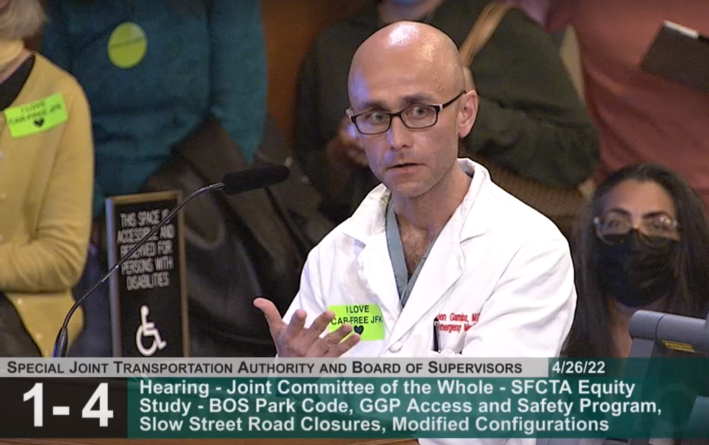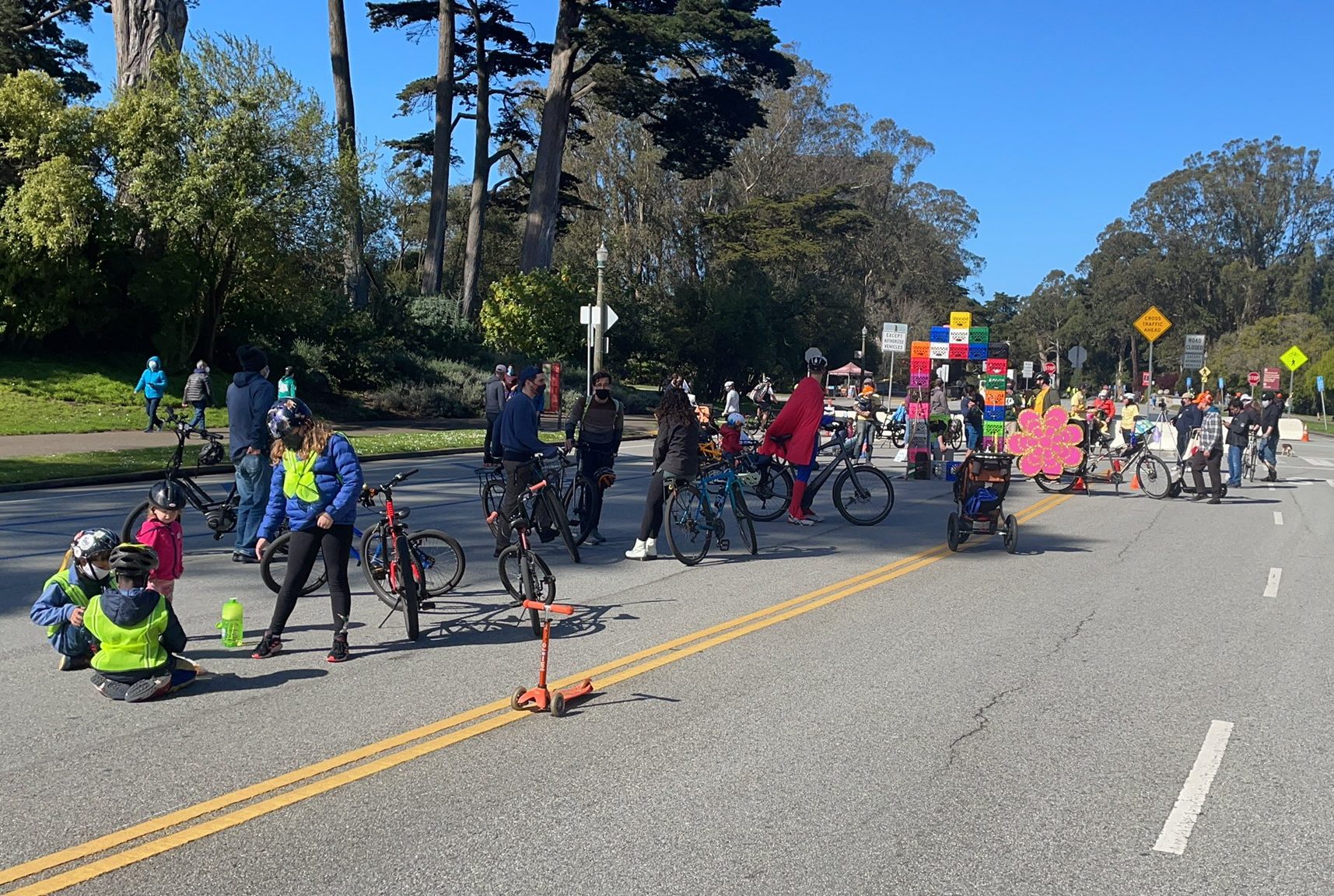Note: GJEL Accident Attorneys regularly sponsors coverage on Streetsblog San Francisco and Streetsblog California. Unless noted in the story, GJEL Accident Attorneys is not consulted for the content or editorial direction of the sponsored content.
Doctor Stephen Gamboa was one of hundreds who came to speak to the San Francisco Board of Supervisors on April 26 to implore them to make car-free J.F.K. permanent. The bill to do so is now the law.
Gamboa told San Francisco lawmakers about his work in the emergency room at Kaiser's San Francisco Medical Center. "I have seen too many injuries on J.F.K., injuries that are totally preventable," he told the Board of Supervisors. "Since J.F.K. was closed to cars I've seen a substantial decrease in those injuries." He also wrote about the decrease in a 2021 op-ed in the SF Examiner.
Streetsblog spoke with Gamboa about the victory on J.F.K., and to get more of his thoughts on the traffic violence epidemic throughout the city.
SBSF: You're a busy physician. What motivated you to make the time to come down to S.F. City Hall to offer your views on the J.F.K. Promenade?
STEPHEN GAMBOA, MD: I have two children. Both learned to ride their bicycles on J.F.K. Statistically the biggest danger to their lives is being killed in a traffic crash, so I wanted to preserve that car-free space for them to play. I also commute to work on J.F.K. I ride with the kids to school every day on J.F.K. in a cargo bike. When I have personal time I go running there. For me it’s a way of life.
Of course, I don't like other people getting injured either and I had to take care of a lot of those folks.
SBSF: In your talk, you brought up the case of a restaurant worker who got a broken arm while biking on J.F.K. because of an erratic driver. I take it you had lots of cases just like that?

GAMBOA: I think people don’t appreciate the injuries that occur on our streets. J.F.K is a high injury corridor, but what does that mean? To know how that really effects a person is different than a number. We keep statistics about fatalities and trauma activations, but it’s a pretty high bar for a trauma activation.
SBSF: Meaning a serious, life-threatening injury? And if it isn't that, they don't really get counted?
GAMBOA: Right. And they go to S.F. General, so we end up with data on where trauma activations occur. But most of the injuries don’t rise to that level - but they are still disabling. I think the most egregious thing is that in a park people expect to be able to recreate safely. Using city streets is dangerous, and we expect some danger, but in a park it’s more shocking.
SBSF: Going from what you wrote in the Examiner, injuries on J.F.K. have basically dropped to zero since it was closed to cars. But opponents of the promenade argued that closing J.F.K. to cars just pushes the traffic--and those injuries--to other streets in the Richmond.
GAMBOA: No, I don’t think that’s the case. We know that separating pedestrians and cyclists from high-energy vehicles--vehicles that can create high energy collisions--reduces injuries simply because they’re separated. If east-west bike traffic is separated from cars, those collisions won’t have any opportunity to occur. Moreover, car-free J.F.K. increases the number of cyclists and pedestrians that travel east-west, so you have fewer cars on the road overall.
SBSF: So basically J.F.K. is now the ultimate separated, protected bike lane?
GAMBOA: You have Fulton and Geary for cars. You can’t bike on those streets; they’re basically reserved for cars. They're arterials, and you can drive very fast on them. But J.F.K. was never designed for that.
SBSF: You presented a letter to the Board with the signatures of seventy healthcare professionals, urging them to keep cars off J.F.K. Do you think all medical professionals should be involved in pushing for safe street policies?
GAMBOA: Yes. Injury prevention has always been a part of public health. The public health infrastructure now has been consumed by the pandemic, but it is and should always be part of public health strategy. It is just as important as heart attack and stroke prevention.
SBSF: Because statistically car crashes take almost as many lives?
GAMBOA: When I see patients in the E.R. and they’re worried, for example, about a wound getting infected, I remind them that the most dangerous thing they will do when they leave the E.R. is to cross Geary Boulevard.
Being a driver has gotten safer because of better engineering. Steering columns used to be like spears that would just push through someone’s chest. Seat belts used to be optional; same with airbags. We made it so drivers of cars are safer.
SBSF: But we haven't done much for people outside of cars.
GAMBOA: I would love to see a breathalyzer ignition lock out that wouldn’t let people drive drunk, or speed regulators. There are plenty of engineering controls that could be done, but I don’t think we have the political will to do so.
SBSF: Why is that? And why is it that Supervisors such as Ahsha Safaí and the others who voted to put cars back on all of J.F.K. can't seem to make the connection between how they vote on these policies and how many people will be injured or even killed?
GAMBOA: I think it’s lack of empathy and lack of imagination. For some folks, the only way they know to get around is in a car. And they’ve never had that experience of being a terrified cyclist. Plus there's this mentality of: well, injuries are going to happen--we accept a certain number as inevitable, and if they don’t happen in one place they’re going to happen in another.
SBSF: Which is not true.
GAMBOA: Given enough money and political will you could bring deaths and injuries down to a number approaching zero. People don’t appreciate there is a choice. All of these engineering decisions are about money and time. As a driver, how much extra time are you willing to spend to save a life or to prevent a disabling injury?
SBSF: I guess for some people it's none. Speaking of which, are you a member of the de Young museum, which lobbied so hard to put cars back on J.F.K.?
GAMBOA: I am. And I'm hopeful that they think this is settled law and they’re not going to pull some kind of ballot measure. I’d rather just show up and visit the museum and show them that people do visit with J.F.K. pedestrianized, if for no other reason than to prove it is still accessible. But I wasn’t planning on renewing.
SFBC: Any other thoughts?
GAMBOA: I wish we could all have a little more compassion for one another. I think we’re all just trying to make a life for ourselves and our families. For some of us that means getting around by bicycle and by foot. If we just remembered that, the streets would be kinder, gentler places.





